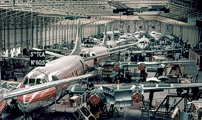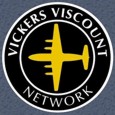
April 1955 to November 1963
Trans-Canada Air Lines (TCA)
CF-TGN - c/n 51 - a V.724 series Viscount
Canada registered
November 1952
An order was placed by Trans-Canada Air Lines (TCA) for fifteen Type 724 aircraft at a total cost of Can$11,500,000. This was the sixth one built.
Production Aircraft No. 52 - the 52nd production Type 700 series Viscount built,
was the 20th Viscount fuselage assembled at Hurn, Bournemouth, Hampshire, England,
and the 24th Viscount assembled at Hurn, Bournemouth, Hampshire, England.
Production Order No. F06/724. Sales Order No. F06/51B. Stock Order No. F20/21B.
24 August 1954
Fuselage assembly commenced at Hurn Airport, Bournemouth, Hampshire, England.

Erecting Shop 'E' at Hurn,
Bournemouth, Hampshire, England
11 October 1954
Fuselage to Erecting Shop 'E' at Hurn Airport, Bournemouth, Hampshire, England.
31 March 1955
First flight from Hurn Airport, Bournemouth, Hampshire, England.
It was fitted with Rolls-Royce Dart RDa3 Mark 506 engines.
21 March 1955
TCA issued technical instruction V-05.04-1/1 to apply the word 'Viscount' to the tail section in 8.5 inch high red letters edged in white at the first opportunity.
7 April 1955
Aircraft passed off by TCA inspectors as completed and ready for delivery.
8 April 1955
Departed from Hurn Airport, Bournemouth, Hampshire, England on delivery to Trans-Canada Air Lines (TCA) with fleet number '606'.
After refuelling at Prestwick Airport, Ayrshire, Scotland it then flew on to Keflavik Airport, Iceland (743 nautical miles) where it stoped overnight.
9 April 1955
Departed from Keflavik Airport, Iceland to Bluie West One (BW1) Airfield, Narsarsuaq, Southern Greenland (804 nautical miles), Goose Bay Airport, Newfoundland & Labrador, Canada (672 nautical miles) where it stopped overnight.
BW1 was built during WWII to assist the transfer of military aircraft from North America to Europe and was opened in January 1942.
31 March 1955
Departed from Goose Bay Airport, Newfoundland & Labrador, Canada to Dorval International Airport, Montreal, Province of Quebec, Canada (810 nautical miles).
2 June 1955
TCA issued technical instruction V-31.02-2/5 to apply the word 'Viscount' to the inside of the passenger loading door in 4 inch high red letters edged in white at the first opportunity.
The cabin seating was installed in Canada, as the seats used by TCA were of American manufacture.
The cabin was fitted out with 40 seats which was a reduction from the original 48 seat specification and provided more leg room.
This was heavily marketed and resulted in a high load factor compared to the 18 seat Douglas DC-3 that it replaced on some routes.
July 1956
Cabin interior changed to a two class 44 seat arrangement.
10 July 1957
TCA issued instructions that all Viscounts would be repainted in a 'White Top' livery when a suitable maintenance period became available.
28 August 1958
Scheduled to enter the Winnipeg Airport, Manitoba, Canada TCA maintenance facility for the replacement of the life expired wing lower inner spar boom at approximately 6300 landings for this component. This usually took 28 days to complete.
31 August 1960
Total time 13,874 hours and 10,774 total landings.
6 September 1962
Withdrawn from service (where?). Details please to information@vickersviscount.net
11 September 1962
Ferried to Timmins Aviation Limited at Dorval International Airport, Montreal, Province of Quebec, Canada for conversion to V.744 standard with an executive interior. The conversion was arranged by William C Wold Associates.
24 June 1963
Noted outside the Timmins Aviation Limited facility at Dorval Airport, Montreal, Province of Quebec, Canada now repainted in a smart executive livery.
Total time 18,180 hours and 14,913 total landings.
20 November 1963
Sold to Canadian Schenley Ltd.
|



